Planning a roof replacement or installation but unsure about costs? A roofing calculator is your essential first step toward an accurate budget. While professional quotes provide exact figures, understanding the factors that influence your roofing project’s cost helps you prepare financially and communicate effectively with contractors. Our comprehensive guide explains how roofing calculations work and what variables affect your bottom line.
What is a Roofing Calculator?
A roofing calculator is a specialized tool that helps homeowners and contractors estimate the materials, labor, and total costs involved in roofing projects. Unlike general construction calculators, roofing calculators account for the unique variables specific to roof installations, including pitch, waste factors, and material-specific requirements.

Roofing calculators help visualize measurements and estimate costs before starting your project
Using a roofing calculator offers several key benefits:
Ready to Calculate Your Roofing Costs?
Get a precise estimate tailored to your specific project needs with our advanced calculator tool.
Factors Affecting Roofing Costs
Understanding what influences roofing costs helps you create more accurate estimates. A comprehensive roofing calculator considers these key variables:
Roof Size and Square Footage
The total area of your roof is the primary factor in determining material quantities and labor costs. Larger roofs require more materials and take longer to install, directly increasing your project’s overall cost.
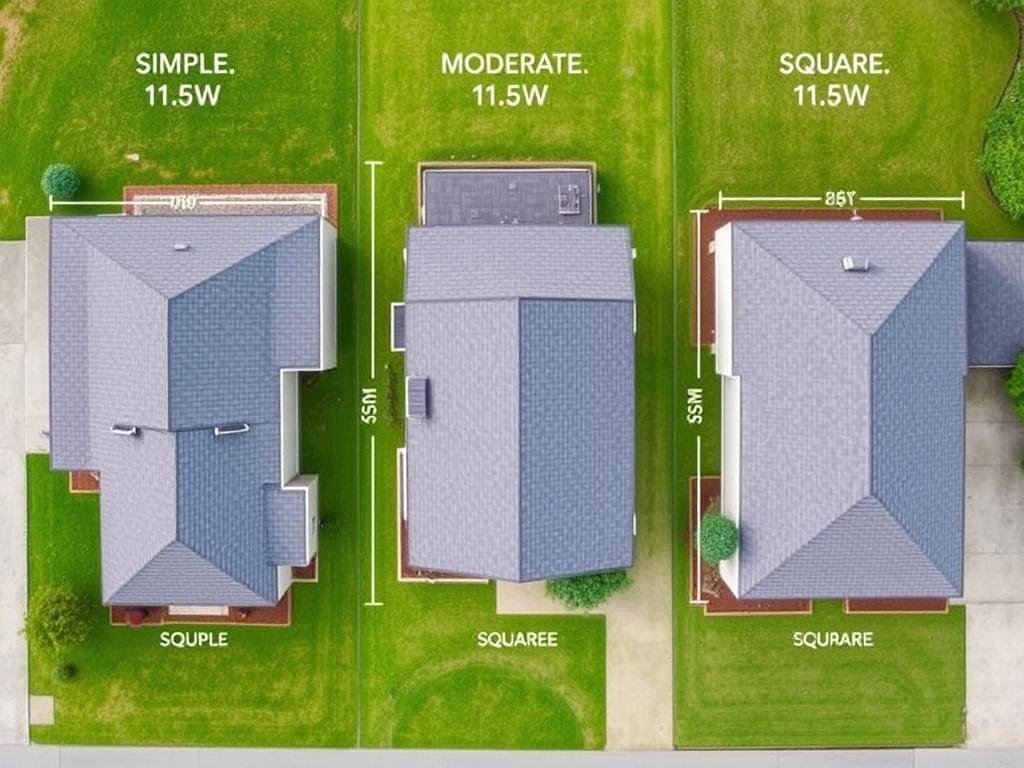
Roof Pitch and Slope
Your roof’s pitch (steepness) significantly impacts both material requirements and installation difficulty. Steeper roofs require more materials to cover the same horizontal area and present greater safety challenges during installation, increasing labor costs.
Low-Pitch Roofs (2:12 to 4:12)
Easier to work on but may require special materials to prevent water penetration. Some materials like standard asphalt shingles aren’t recommended for very low slopes.
Steep-Pitch Roofs (6:12 and above)
Require additional safety equipment, take longer to install, and typically cost 20-40% more in labor compared to moderate pitches. They also need more materials to cover the same floor area.
Roofing Material Type
Material choice dramatically affects your total roof replacement cost. Each material comes with different price points, lifespans, and installation requirements.
| Roofing Material | Cost Per Square Foot | Average Lifespan | Installation Complexity |
| 3-Tab Asphalt Shingles | $3.40 – $4.65 | 15-20 years | Low |
| Architectural Shingles | $4.11 – $5.95 | 25-30 years | Low-Medium |
| Metal Roofing | $6.00 – $24.50 | 40-70 years | Medium-High |
| Clay/Concrete Tiles | $6.30 – $12.30 | 50-100 years | High |
| Wood Shakes/Shingles | $6.00 – $9.15 | 25-40 years | Medium |
| Slate Roofing | $23.49 – $31.77 | 75-150 years | Very High |
Roof Complexity
Complex roof designs with multiple levels, dormers, valleys, and penetrations require more materials and labor. Each cut, valley, and flashing point increases installation time and the potential for future maintenance issues.
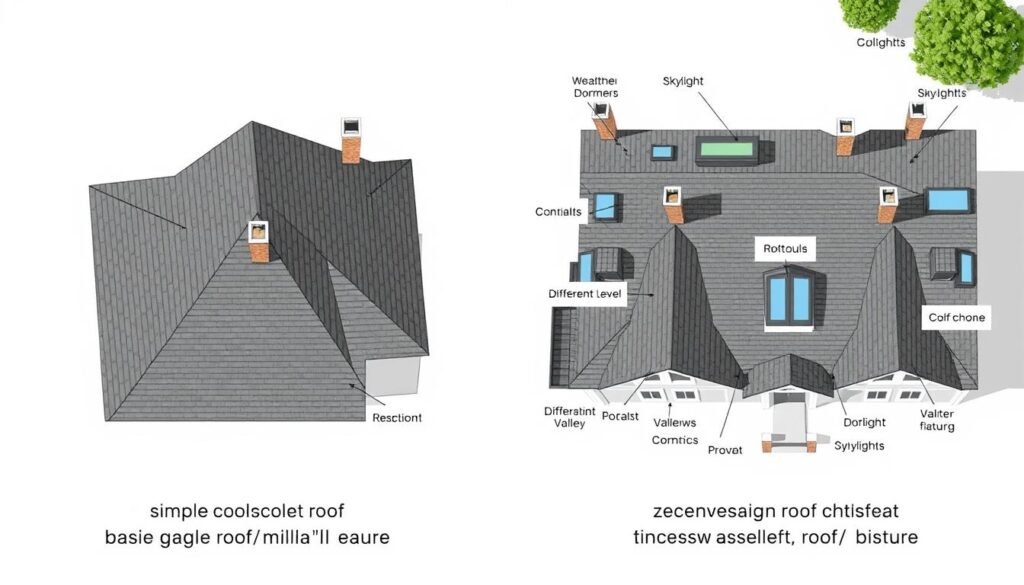
Removal of Existing Roofing
Removing old roofing materials adds significant labor costs to your project. The number of existing layers, material type, and disposal fees all factor into this expense.
Single Layer Removal
Typically costs between $0.40 – $0.80 per square foot for asphalt shingles, making it the most affordable removal option.
Multiple Layer Removal
Can increase costs by 25-50% per additional layer and may reveal hidden structural issues requiring repair.
Geographic Location
Your location affects roofing costs through regional material pricing, labor rates, building code requirements, and climate considerations. Urban areas typically have higher labor costs than rural regions.
Additional Components
A complete roofing system includes more than just the visible materials. Underlayment, decking repairs, ventilation, flashing, and other components all contribute to your total project cost.
Need a Precise Roofing Estimate?
Our advanced roofing calculator considers all these factors to provide you with an accurate cost projection.
How to Manually Calculate Your Roofing Needs
While online calculators provide convenience, understanding how to perform basic roofing calculations manually gives you valuable insight into your project. Follow these steps to calculate your roof area and material needs:
Step 1: Calculate Your Roof’s Area
For simple roofs, you can estimate the area using basic measurements and formulas:

Gable Roof
Area = Length × Width × Pitch Factor
Where pitch factor adjusts for the slope:
4/12 pitch: 1.054
6/12 pitch: 1.118
8/12 pitch: 1.202
12/12 pitch: 1.414
Hip Roof
Area = Length × Width × Pitch Factor × 1.07
The additional 1.07 multiplier accounts for the extra area of the hip sections.
Shed Roof
Area = Length × Width × Pitch Factor
Simplest calculation as there’s only one plane.
Step 2: Convert to Roofing Squares
Roofing materials are typically sold by the “square” – a unit equal to 100 square feet of roof area.
Roofing Squares = Total Roof Area (sq ft) ÷ 100
Step 3: Account for Waste Factor
Always add a waste factor to account for cuts, overlaps, and damaged materials:
Step 4: Calculate Additional Materials
Don’t forget to calculate other essential components:
| Component | Calculation Method |
| Underlayment | Same as roof area + 15% waste |
| Starter Shingles | Linear feet of roof edges and rakes |
| Ridge Caps | Linear feet of ridges and hips |
| Drip Edge | Linear feet of roof perimeter |
| Ice & Water Shield | Linear feet of eaves × width needed (typically 3-6 feet) |

Pro Tip: For complex roofs, break the structure into simple geometric shapes (rectangles, triangles), calculate each area separately, then add them together for the total roof area.
Skip the Manual Calculations
Let our roofing calculator do the math for you – get accurate material estimates in seconds.
Types of Roofing Materials: Costs and Considerations
Your choice of roofing material significantly impacts both the upfront cost and long-term value of your roof. Here’s a detailed comparison to help you make an informed decision:
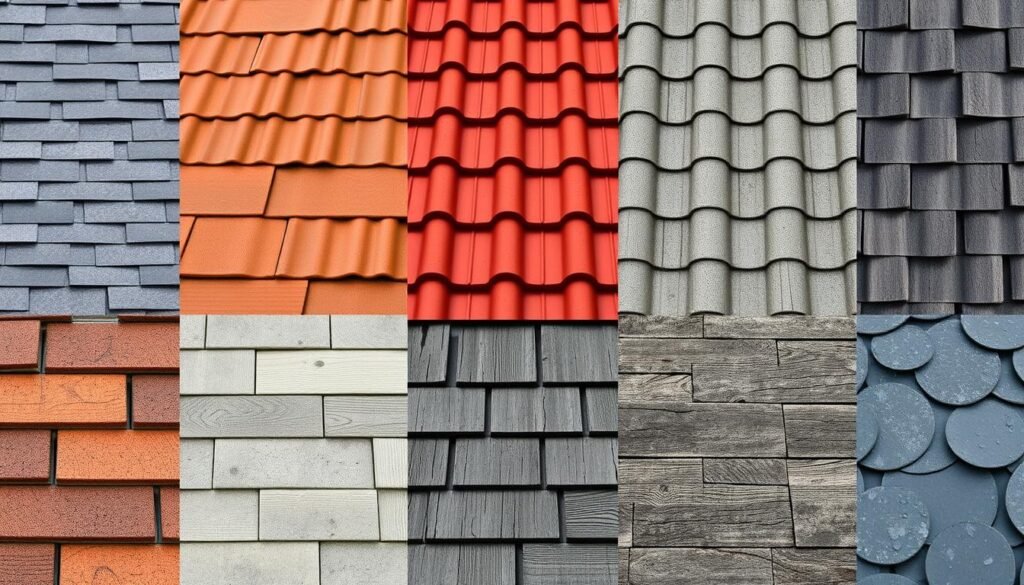
Asphalt Shingles
The most popular roofing material in the United States due to their balance of affordability and performance.
Advantages
- Most affordable option ($3.40-$5.95 per sq ft)
- Wide variety of colors and styles
- Relatively easy installation
- Good fire resistance
- 15-30 year lifespan depending on quality
Disadvantages
- Shorter lifespan than premium materials
- Less environmentally friendly
- Can be damaged by extreme weather
- Poor insulation properties
- Prone to algae/moss growth in humid areas
Metal Roofing
Growing in popularity for its durability and energy efficiency, metal roofing comes in various forms including standing seam panels, metal shingles, and corrugated sheets.
Advantages
- Exceptional longevity (40-70 years)
- Highly durable against weather
- Energy efficient (reflects solar heat)
- Lightweight
- Fire resistant
- Environmentally friendly (recyclable)
Disadvantages
- Higher initial cost ($6.00-$24.50 per sq ft)
- Can be noisy during rain/hail
- May dent from severe impacts
- Installation requires specialized skills
- Some types may be prone to rust without proper coating
Tile Roofing (Clay and Concrete)
Popular in Mediterranean, Spanish, and southwestern architectural styles, tile roofing offers distinctive aesthetics and exceptional longevity.
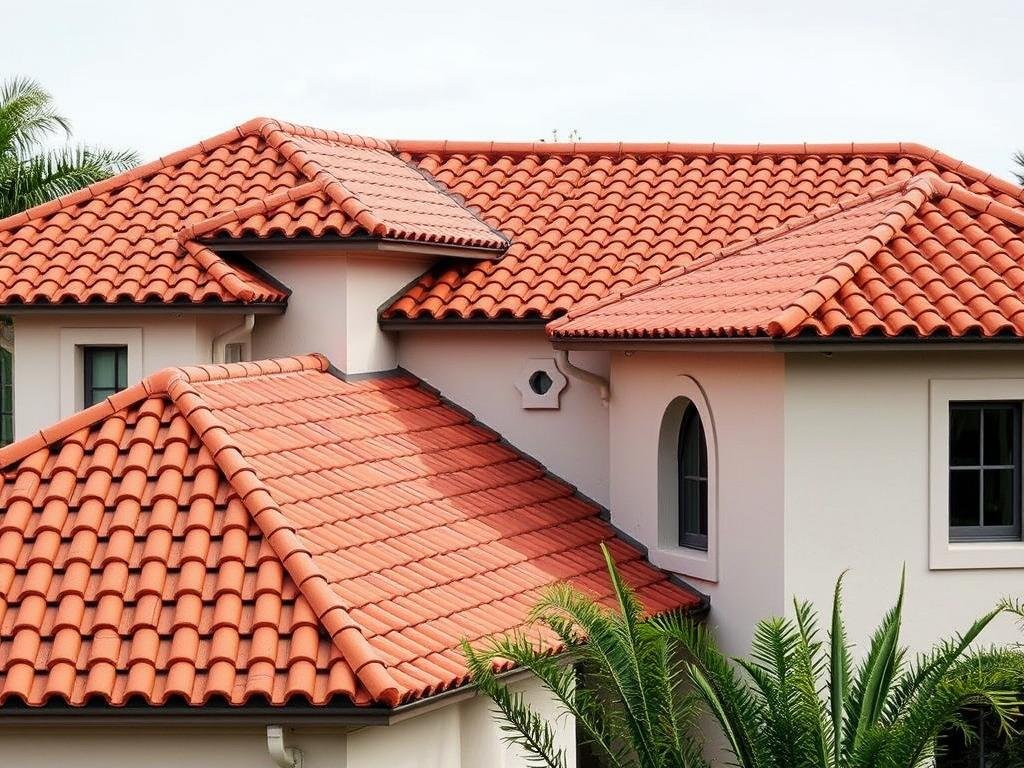
Advantages
- Extremely long-lasting (50-100+ years)
- Excellent insulation properties
- Distinctive aesthetic appeal
- Highly fire resistant
- Resistant to insects and rot
- Low maintenance requirements
Disadvantages
- Premium cost ($6.30-$12.30 per sq ft)
- Very heavy (may require structural reinforcement)
- Brittle and can crack from impact
- Complex and expensive installation
- Limited color options (especially for clay)
Wood Shakes and Shingles
Offering natural beauty and character, wood roofing provides a distinctive rustic appearance that many homeowners desire.
Advantages
- Natural, rustic aesthetic
- Good insulation properties
- Environmentally sustainable (if responsibly sourced)
- Can last 25-40 years with proper maintenance
- Naturally weather to an attractive silver-gray
Disadvantages
- Requires regular maintenance
- Susceptible to mold, rot, and insect damage
- Poor fire resistance (unless treated)
- Higher insurance costs in some areas
- Not permitted in some fire-prone regions
Slate Roofing
The premium choice for roofing, natural slate offers unmatched longevity and timeless elegance.

Advantages
- Exceptional longevity (75-150+ years)
- Unmatched aesthetic appeal
- Completely fireproof
- Excellent insulation properties
- Environmentally friendly (natural stone)
- Adds significant property value
Disadvantages
- Highest cost option ($23.49-$31.77 per sq ft)
- Extremely heavy (requires substantial structural support)
- Brittle and can crack if walked on
- Limited color options
- Requires specialized installation expertise
Compare Roofing Material Costs for Your Project
Our calculator helps you compare different materials and see how they impact your total project cost.
Why Accurate Roofing Estimates Matter
Precise roofing calculations are crucial for a successful project. Here’s why getting your estimates right from the start makes a significant difference:

Consequences of Underestimating
Underestimating your roofing needs can lead to several costly problems:
Problems with Overestimating
While less problematic than underestimating, ordering too much material has its own drawbacks:
Benefits of Precise Estimates
Getting your calculations right provides numerous advantages:
Did you know? Professional roofing contractors typically add a 10-15% waste factor to their material calculations. This accounts for cuts, overlaps, damaged materials, and complex roof features.
Get Your Precise Roofing Estimate Today
Our advanced roofing calculator provides accurate estimates tailored to your specific project needs.
Common Roofing Calculation Mistakes to Avoid
Even small errors in your roofing calculations can lead to significant problems. Here are the most common mistakes homeowners make and how to avoid them:

Warning: Never walk on your roof to take measurements unless you have proper safety equipment and experience. Roof falls are extremely dangerous. Consider using satellite measurements or hiring a professional for accurate dimensions.
Avoid Calculation Mistakes
Our roofing calculator eliminates common errors by using proven formulas and accounting for all variables.
When to Get Professional Roofing Estimates
While calculators provide valuable preliminary figures, certain situations call for professional assessment. Here’s when to consult with roofing experts:
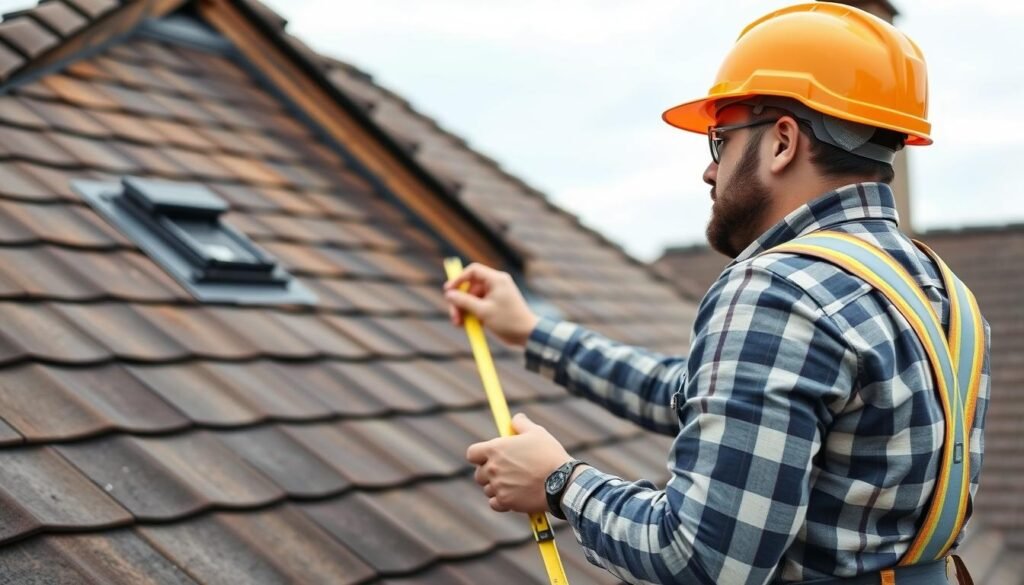
Professional roofers bring valuable expertise to your project, including:
Precise Measurements
Contractors use specialized tools and techniques to measure complex roof structures accurately.
Material Expertise
Professionals can recommend the best materials for your specific climate and roof design.
Problem Identification
Trained eyes spot potential issues that might be missed in DIY assessments.
“The most expensive estimate is often the one you create yourself without proper knowledge of all the variables involved.”
Start With an Accurate Estimate
Use our roofing calculator for a preliminary estimate, then consult with professionals for verification.
Getting Started With Your Roofing Project
Armed with knowledge about roofing calculations and material options, you’re now better prepared to plan your roofing project. Remember these key takeaways:
Whether you’re planning a simple repair or complete roof replacement, proper calculations help you budget effectively, communicate clearly with contractors, and ensure your project runs smoothly from start to finish.
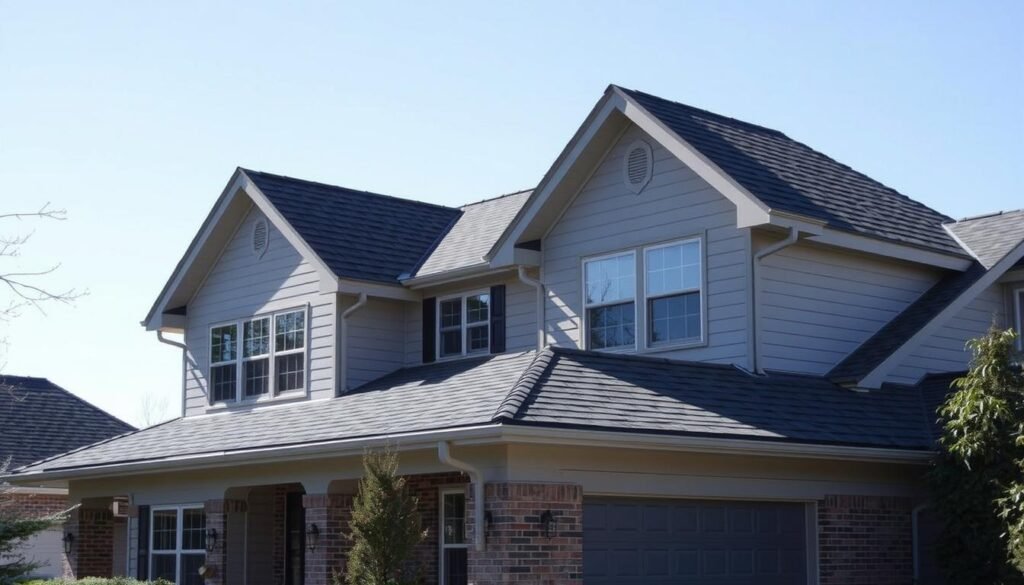
Ready to Start Your Roofing Project?
Get an accurate, comprehensive estimate with our advanced roofing calculator.